It has been an extraordinary year here for bulbocodiums. The intra-sectional hybrids were great company over the winter. The inter-sectional hybrids are exploding in diversity and yielding all sorts of unexpected fertility.
The foundation flower for this inter-sectional explosion is 02/1MB. It’s pollen is poor but it reliably sets a few seeds per pod.
Most surprising was a single seed from 10/8MB = 02/1MB x 02/2MJ = (Alfriston x bulbocodium) x (fernandesii x Redlands Too). This seedling (and the type generally) is extremely vigorous but quite sterile so I didn’t record what pollen I splashed onto its many flowers (and I certainly no longer remember).
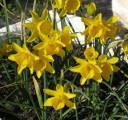
A little less surprising, but nevertheless notable, was seed from 13/8MB. It is 02/1MB x 06/122B. It looks quite like a bulbocodium but has smoothness and substance that is superior to typical bulbocodiums.

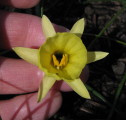
Similar is 13/30MB, which is 02/1MB x 07/131B. It first flowered in 2010 but was given a selection number this year when it set seed to a different fertile intersection bulbocodium hybrid (13/22MB). A good specimen was put in the Canberra show (non miniature). I didn’t take a photo but Kyrill Harding has kindly sent me a picture (and so the copyright is his, not mine) . Generalising from these results, it seems likely that 02/1MB backcrossed onto bulbocodiums produces improved bulbocodium style flowers. Unfortunately the orange color has not emerged in these flowers.
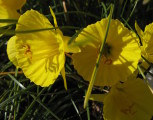
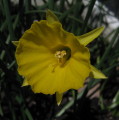

13/27MB is 02/1MB x ~1Y-YYO. The orange flush suggests the pedigree may be wrong and that Terminator or 02/191 (-> 1O-R) may be responsible. This is easily intermediate but not miniature – although it may nevertheless have potential in this regard. One unsuccessful seed has been obtained from a similar cross to this so given the above fertilities it is hard to ignor the possibility that greater flower numbers may yield good seed numbers and possibly useful hybrids. Colored main division miniatures via bulbocodiums is a most unexpected possibility.
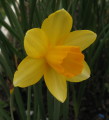
Not to be outdone, 02/1MB x 04/1RM (the triandrus hybrid mentioned in my Div. 5 fertility update, which gives fertile hybrids with Mission Bells) is producing flowers with reliable fertility. 13/17MB did not set seed this year but some of its siblings, both single and multi-headed, have. Whether hybrids such as this can be pushed into fertile triandrus, main division miniatures, or bulbocodiums remains to be seen.
One of 02/1MB’s seedlings is the fully fertile inter-sectional hybrid 10/4MB. It is a reliable plant and good seeder but it doesn’t increase as quickly as its siblings (which first flowered a year earlier in 2009). It’s first seedlings will flower next year hopefully. 09/9MB is almost fully fertile and has produced seedlings such as 13/6MB, which appears to be fully fertile, so there seems little doubt that 10/4MB selfed will produce a race of fertile intersectional hybrids.
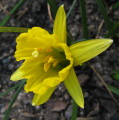
One of the sterile seedlings from 02/1MB (09/6MB) has open pollinated to produce 13/5MB. It is almost indistinguishable from bulbocodiums but it has more substance, I fancy. It has demonstrable pollen fertility.
These hybrids make the question more pressing as to what a division 10 flower, and more particularly, what a good division 10 flower, looks like. Given that main division x triandrus is div. 5, main division x jonquilla is div. 7 and main division x tazetta is div. 8 it seems clear that main division x bulbocodium is div. 10. It seems unfair to condemn div. 10 to being species-like in perpetuity (with “no admixture” – as used to be the case for div. 9). My own view is that 13/27MB is a division 2 intermediate and that 13/15MB (below) is a good div. 10. Trivial as it may seem, the curved sigma seems a useful criterion, but I am doubtful that it will prove to be a decisive one.
My experience with inter-crossing bulbocodiums and main division flowers has been very disappointing. Most crosses have failed and when seed is produced it turns to chaff. This year a second inter-sectional hybrid flowered from just one seed from Flash Affair x 03/203B. I have no idea why I made the cross – perhaps the faint bicolor, perhaps the incurved corona. This hybrid is vigorous, producing three flowers in its first year. Furthermore, it is fully fertile.

Crosses in the reverse direction have been similarly unrewarding but with the added frustration that open pollination occurs readily and the seeds produced are typically not true to cross. So just to round off the season, to my great surprise, another apparently fertile hybrid flowered that is 03/167B x Parton ZR45/54 (Red Hen x Dateline 2O-R). It certainly challenges the notion of what a div. 10 looks like. If it is div. 10 then it is 10Y-O. If it is not then this would suggest we expect division 10 to have long coronas.
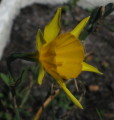

So, as I say, it has been an extraordinary year for bulbocodiums. They have always been exceptional in their ratio of flower mass to leaf mass and bulb size. It seems they may also have exceptional fertility.

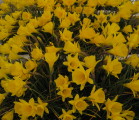
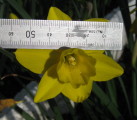

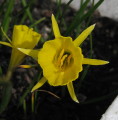
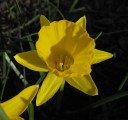
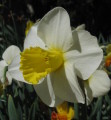
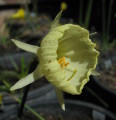
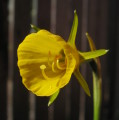

Lawrence:
As usual you are doing amazing things. I hope the Aussies appreciate you as much as we do in the US.
Now how do we get our hands on some of these wonderful plants?
Harold
Thanks Harold,
And warm congratulations on your latest award.
I made an undertaking a year ago to sort out bulb export but still haven’t managed it. Will try again soon. I don’t think there are barriers to seed anywhere. I plan to do a seed list shortly if you are interested.